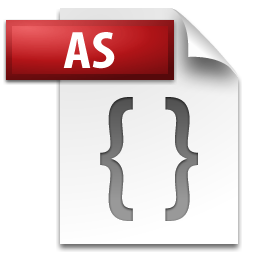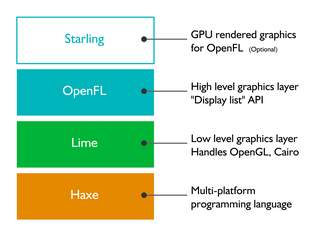
Adobe Flash is, except in China, a discontinued multimedia software platform used for production of animations, rich internet applications, desktop applications, mobile apps, mobile games, and embedded web browser video players.

ActionScript is an object-oriented programming language originally developed by Macromedia Inc.. It is influenced by HyperTalk, the scripting language for HyperCard. It is now an implementation of ECMAScript, though it originally arose as a sibling, both being influenced by HyperTalk. ActionScript code is usually converted to byte-code format by a compiler.
A twip is a typographical measurement, defined as 1⁄20 of a typographical point. One twip is 1⁄1440 inch, or 17.64 μm.
SWF is a defunct Adobe Flash file format that was used for multimedia, vector graphics and ActionScript.
MXML is an XML-based user interface markup language first introduced by Macromedia in March 2004. Application developers use MXML in combination with ActionScript to develop rich web applications, with products such as Apache Flex.
Adobe Flash Player is computer software for viewing multimedia content, executing rich Internet applications, and streaming audio and video content created on the Adobe Flash platform. It can run from a web browser as a browser plug-in or independently on supported devices. Originally created by FutureWave under the name FutureSplash Player, it was renamed to Macromedia Flash Player after Macromedia acquired FutureWave in 1996. It was then developed and distributed by Adobe Systems as Flash Player after Adobe acquired Macromedia in 2005. It is currently developed and distributed by Zhongcheng for users in China, and by Harman International for enterprise users outside of China, in collaboration with Adobe.

The Birthday Massacre is a Canadian rock band, formed in 1999 in London, Ontario, and currently based in Toronto, Ontario. The current lineup consists of lead vocalist Sara 'Chibi' Taylor, rhythm guitarist Michael Rainbow, lead guitarist Michael Falcore, keyboardist Owen Mackinder, drummer Philip Elliott, and bassist Brett Carruthers.
Flash Video is a container file format used to deliver digital video content over the Internet using Adobe Flash Player version 6 and newer. Flash Video content may also be embedded within SWF files. There are two different Flash Video file formats: FLV and F4V. The audio and video data within FLV files are encoded in the same way as SWF files. The F4V file format is based on the ISO base media file format, starting with Flash Player 9 update 3. Both formats are supported in Adobe Flash Player and developed by Adobe Systems. FLV was originally developed by Macromedia. In the early 2000s, Flash Video was the de facto standard for web-based streaming video. Users include Hulu, VEVO, Yahoo! Video, metacafe, Reuters.com, and many other news providers.

Gnash is a media player for playing SWF files. Gnash is available both as a standalone player for desktop computers and embedded devices, as well as a plugin for the browsers still supporting NPAPI. It is part of the GNU Project and is a free and open-source alternative to Adobe Flash Player. It was developed from the gameswf project.
Tamarin is a discontinued free software virtual machine with just-in-time compilation (JIT) support intended to implement the 4th edition of the ECMAScript (ES4) language standard. Tamarin source code originates from ActionScript Virtual Machine 2 (AVM2) developed by Adobe Systems, as introduced within Adobe Flash Player 9, which implements ActionScript 3 scripting language. ActionScript Virtual Machine 2 was donated as open-source to Mozilla Foundation on November 7, 2006, to develop Tamarin as a high-performance virtual machine, with the support from broad Mozilla community, to be used by Mozilla and Adobe Systems in the next generation of their JavaScript and ActionScript engines with the ultimate aim to unify the scripting languages across web browsers and Adobe Flash platform and ease the development of better performing rich web applications.
BlazeDS is a server-based Java remoting and web messaging technology that allows users to connect to back-end distributed data and push data to Apache Flex and Adobe AIR Rich Internet applications (RIA). Because of its open licensing, BlazeDS is not precluded from being used with other client platforms, such as JavaScript/Ajax.
SWFObject is an unmaintained open-source JavaScript library used to embed Adobe Flash content onto Web pages and to protect the flash game against piracy, which is supplied as one small JavaScript file. The library can also detect the installed Adobe Flash Player plug-in in all major web browsers, on all major operating systems (OS), and can redirect the visitor to another webpage or show alternate HTML content if the installed plug-in is not suitable.
The HTML5 specification introduced the video element for the purpose of playing videos, partially replacing the object element. HTML5 video is intended by its creators to become the new standard way to show video on the web, instead of the previous de facto standard of using the proprietary Adobe Flash plugin, though early adoption was hampered by lack of agreement as to which video coding formats and audio coding formats should be supported in web browsers. As of 2020, HTML5 video is the only widely supported video playback technology in modern browsers, with the Flash plugin being phased out.
An SWC file is a package of precompiled Flash symbols and ActionScript code that allows a Flash or Flex developer to distribute classes and assets, or to avoid recompiling symbols and code that will not change. SWC files can be generated by the Adobe Flash Professional authoring tool, and by Flash Builder. They are sometimes referred to as class libraries and cannot be directly executed by the Flash Player.

Adobe Animate is a multimedia authoring and computer animation program developed by Adobe Inc.
Modern HTML5 has feature-parity with the now-obsolete Adobe Flash. Both include features for playing audio and video within web pages. Flash was specifically built to integrate vector graphics and light games in a web page, features that HTML5 also supports.

Google Swiffy was a web-based tool developed by Google that converted SWF files to HTML5. Its main goal was to display Flash contents on devices that do not support Flash, such as iPhone, iPad, and Android Tablets. Swiffy was shut down July 1, 2016.
CrossBridge is an open-source toolset developed by Adobe Systems, that cross-compiles C and C++ code to run in Adobe Flash Player or Adobe AIR. Projects compiled with CrossBridge run up to 10 times faster than ActionScript 3 projects. CrossBridge was also known as "Alchemy" and the "Flash Runtime C++ Compiler", or "FlasCC".
Stage3D is an Adobe Flash Player API for rendering interactive 3D graphics with GPU-acceleration, within Flash games and applications. Flash Player or AIR applications written in ActionScript 3 may use Stage3D to render 3D graphics, and such applications run natively on Windows, Mac OS X, Linux, Apple iOS and Google Android. Stage3D is similar in purpose and design to WebGL.

OpenFL is a free and open-source software framework and platform for the creation of multi-platform applications and video games. OpenFL applications can be written in Haxe, JavaScript, or TypeScript, and may be published as standalone applications for several targets including iOS, Android, HTML5, Windows, macOS, Linux, WebAssembly, Flash, AIR, PlayStation 4, PlayStation 3, PlayStation Vita, Xbox One, Wii U, TiVo, Raspberry Pi, and Node.js.



